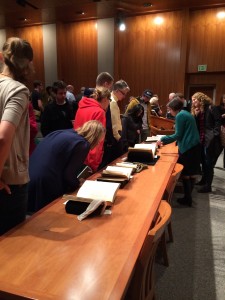A BYU illustration professor shared the inspiration she finds in a fellow illustrator who lived over a hundred years ago — Arthur Rackham.
In the lecture, professor Bethanne Anderson outlined some currently well-known artists she feels were influenced by Rackham including Kinuko Craft, Charles Vess and Tim Burton.
Rackham, a famous English illustrator born in the late 1800s, is well known for his water color fantasy works that included his own depictions of the Brothers Grimm stories, Alice in Wonderland, Aesop’s Fables and much more.

“Whenever I talk about Arthur Rackham it is like my dream came true; I love this man,” Anderson said. “Rarely do I meet an artist that doesn’t mention Arthur Rackham as an influence.”
Shannon McCurdy, a BYU student studying theater studies, was in attendance to gain ideas for costume designs and admire the fairies in Rackham’s works.
“I saw the pictures, and I am secretly a fairy princess,” McCurdy said.
Anderson said Tim Burton and Rackham seem to share a “cuddly darkness” in their works.
“His stuff always had a touch of darkness in it,” Anderson said, referring to Rackham.
She felt this was likely a result of the many deaths of his siblings and Rackham’s stillborn first daughter.
The lecture focused on the challenges the fantasy illustrator faced in his life and how he eventually overcame them. Anderson noted that art did not come naturally to Rackham and he spent years improving his skill.
The lecture also focused on Rackham’s humility and determination despite monetary or physical obstacles. He struggled at first to become a good artist, so his career started late, resulting in a more humble outlook on life for him.
Despite early struggles in landscape art, Rackham succeeded in creating his own niche in fantasy art when his wife encouraged him to display his fantasy illustrations at the Royal Watercolor Show.
Anderson also pointed out eccentricities the artist had such as a trapeze in his studio. Furthermore, when creating his own sketches of Alice and Wonderland, he interviewed little girls to find a model for Alice. After his interviews he chose a blonde girl with an absurd, self-made dress and stockings.
During his rise to fame, Rackham was approached about illustrating “The Little White Fairies” by J.M. Barrie, later renamed “Peter Pan.” Anderson said fairy illustrations, swashbuckling characters and animals were characteristic of his work, and some of the “Peter Pan” illustrations are particularly well known.
After struggling to get by during WWI, the artist gained a lot of attention in America.
“Walt Disney wanted to hire him to help him with ‘Snow White,’” Anderson said.
Unfortunately, at this point in his life Rackham was struggling with failing health so he declined.
One of Rackham’s late achievements was his contribution to “The Wind in the Willows” by Kenneth Grahame. When approached about the project, the artist was struggling with cancer but said it was one of his dreams to illustrate it, so he consented. Rackham was able to finish his sketches for the book just three days before he passed away.




